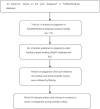Knowing and avoiding plagiarism during scientific writing
- PMID: 25364588
- PMCID: PMC4212376
- DOI: 10.4103/2141-9248.141957
Knowing and avoiding plagiarism during scientific writing
Abstract
Plagiarism has become more common in both dental and medical communities. Most of the writers do not know that plagiarism is a serious problem. Plagiarism can range from simple dishonesty (minor copy paste/any discrepancy) to a more serious problem (major discrepancy/duplication of manuscript) when the authors do cut-copy-paste from the original source without giving adequate credit to the main source. When we search databases like PubMed/MedLine there is a lot of information regarding plagiarism. However, it is still a current topic of interest to all the researchers to know how to avoid plagiarism. It's time to every young researcher to know ethical guidelines while writing any scientific publications. By using one's own ideas, we can write the paper completely without looking at the original source. Specific words from the source can be added by using quotations and citing them which can help in not only supporting your work and amplifying ideas but also avoids plagiarism. It is compulsory to all the authors, reviewers and editors of all the scientific journals to know about the plagiarism and how to avoid it by following ethical guidelines and use of plagiarism detection software while scientific writing.
Keywords: Plagiarism; Scientific writing; Unethical publication practice.
Conflict of interest statement
Figures
Similar articles
-
Plagiarism: Why is it such a big issue for medical writers?Perspect Clin Res. 2011 Apr;2(2):67-71. doi: 10.4103/2229-3485.80370. Perspect Clin Res. 2011. PMID: 21731858 Free PMC article.
-
Rising from Plagiarising.J Maxillofac Oral Surg. 2015 Sep;14(3):538-40. doi: 10.1007/s12663-014-0705-x. Epub 2014 Oct 21. J Maxillofac Oral Surg. 2015. PMID: 26225041 Free PMC article. Review.
-
Text recycling: Self-plagiarism in scientific writing.Int J Womens Dermatol. 2018 Nov 9;5(2):134-136. doi: 10.1016/j.ijwd.2018.10.002. eCollection 2019 Jun. Int J Womens Dermatol. 2018. PMID: 30997390 Free PMC article.
-
Plagiarism detection and prevention: a primer for researchers.Reumatologia. 2021;59(3):132-137. doi: 10.5114/reum.2021.105974. Epub 2021 May 13. Reumatologia. 2021. PMID: 34538939 Free PMC article.
-
Plagiarism in scientific research and publications and how to prevent it.Mater Sociomed. 2014 Apr;26(2):141-6. doi: 10.5455/msm.2014.26.141-146. Epub 2014 Apr 11. Mater Sociomed. 2014. PMID: 24944543 Free PMC article. Review.
Cited by
-
Principles and practice of plagiarism: Perpetrators' perspective.J Pharmacol Pharmacother. 2015 Apr-Jun;6(2):61-2. doi: 10.4103/0976-500X.155480. J Pharmacol Pharmacother. 2015. PMID: 25969650 Free PMC article. No abstract available.
-
Mastering the scientific peer review process: tips for young authors from a young senior editor.J For Res (Harbin). 2022;33(1):1-20. doi: 10.1007/s11676-021-01388-8. Epub 2021 Sep 16. J For Res (Harbin). 2022. PMID: 34545272 Free PMC article.
-
Preparing and Publishing a Scientific Manuscript.J Hum Reprod Sci. 2017 Jan-Mar;10(1):3-9. doi: 10.4103/jhrs.JHRS_36_17. J Hum Reprod Sci. 2017. PMID: 28479749 Free PMC article. Review.
-
Ignorism.Int J Trichology. 2023 Jan-Feb;15(1):1-2. doi: 10.4103/ijt.ijt_125_21. Epub 2023 Apr 19. Int J Trichology. 2023. PMID: 37305185 Free PMC article. No abstract available.
-
Free software applications for authors for writing a research paper.J Family Med Prim Care. 2023 Sep;12(9):1802-1807. doi: 10.4103/jfmpc.jfmpc_418_23. Epub 2023 Sep 30. J Family Med Prim Care. 2023. PMID: 38024912 Free PMC article. Review.
References
-
- Jones LR. Academic Integrity and Academic Dishonesty: A Handbook about Cheating and Plagiarism. Revised and Expanded edition of Florida institute of technology. 2001
-
- Ponniah I. Plagiarism and scientific writing: A personal commentary. J Investig Clin Dent. 2012;3:304–6. - PubMed
-
- Jagadesh Kumar M. Being wary of plagiarism. IETE Tech Rev. 2008;25:231–233.
Publication types
LinkOut - more resources
Full Text Sources
Other Literature Sources


